 |
||
|
||
| ||
In the fourth part of the SPEC CPU2000 review we will examine its operation on different platforms for the AMD Athlon XP processor. Besides, we will see how BIOS settings of mainboards affect the test results. The VIA KT133A based board wasn't included in the test because the other platforms are designed for DDR SDRAM, and as you might remember from the Intel Pentium 4 tests the PC133 memory worsens the speed in all SPEC CPU2000 tests. The AMD 760 was replaced with the latest AMD chipset's modification - 760MPX. The following configurations were used:
SPEC CPU2000 v1.1 configuration:
As you already know, an operating speed of mainboards based on the same chipset doesn't differ much. The only exception is when the BIOS is buggy or clock oscillators are inaccurate. For most of the boards we chose "Load Optimized Defaults", and it is a starting point in our attempts to increase the speed. Note that BIOS settings usually differ and it always hampers direct comparison of boards. Memory overclocking potential can also depend on a board. For example, we could set the best efficiency parameters for the memory for the Gigabyte board in both cases (DDR266 and DDR333), though the ABIT board didn't allow us to set Command Rate in the 1T. Taking into account that default settings are defined by a board maker and BIOS and that most of users do not spend much time on fine settings the speed gained after manual installation of optimal parameters of memory operation can be considered a measure of quality of BIOS realization. And this should also be taken into account when purchasing a board. Let's start with the latest VIA's chipset - KT333. VIA KT333 chipsetApart from setting memory timings in the BIOS there is one more way to boost up the performance - by using the PC2700 memory working at 333 MHz (DDR). Though you shouldn't expect much from it in a pure computational test. 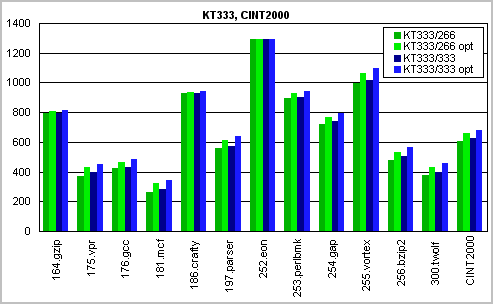  In the CINT2000 setting of minimal memory latency is weightier (the performance rises by approximately 8%) than increasing of its frequency (here we have 3%). In the CFP2000 we have 11% performance gain for latency optimization and 6% for the DDR333. Both tests show that good PC2100 memory (i.e. with minimal timings) can be better than some samples of PC2700. As the test doesn't work with a hard disc and video nobody expected a great gain from the 333 MHz DDR memory, though 12-15% gained in some subtests look interesting (the maximum possible is 25%). VIA KT266A chipsetThis classical chipset is still popular with both manufacturers and customers.   The fine adjustment of the BIOS settings allows for 7% and 12% for the integer and real arithmetic respectively. Note that the figures depend mostly on how correctly the BIOS is written. The second factor is quality of memory modules and adequacy of data recorded in the SPD. AMD 760MPX chipsetThe follower of a very successful chipset together with the most popular DDR SDRAM showed excellent results. AMD enters the market of dual-processor systems with the 760MP chipset, and the 760MPX with a new south bridge adds the PCI64/66 MHz support for such configurations. 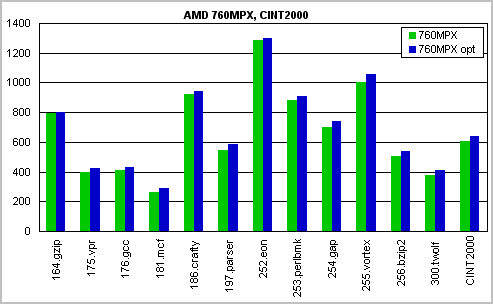 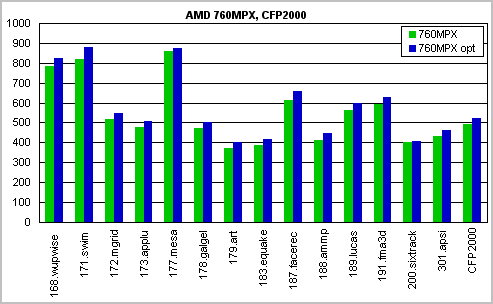 ASUS squeezes everything out of the chipsets - the manual installation of settings adds only 5.3/6% to the INT/FP scores. As a new product it looks very attractive. The highest gain was obtained in the 181.mcf - 11% (this is the most memory sensitive test of the CINT2000 suite). ALi MAGiK 1C chipsetThis is one more chipset supporting DDR333. The latest BIOS version makes possible to set a memory frequency at 166 MHz at the 133 MHz FSB. 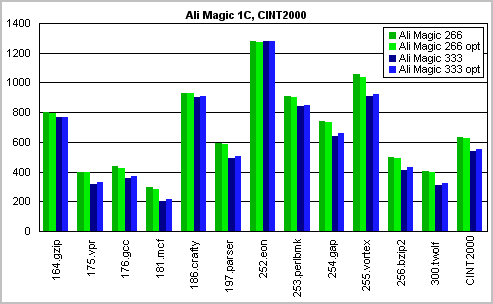  Though the results show that it doesn't make any good. The speed in the DDR333 is lower than in the DDR266. And the default settings for the PC2100 are optimal, and an attempt to set other parameters was unsuccessful. Maybe some settings in the manual mode are made by the BIOS without asking a user. NVIDIA nForce 420D chipsetOur sample of the mainboard offered just one memory setting - SDRAM CAS Latency. Besides, we used two configurations of the memory modules with this chipset - two (in the first and second slots) and one (in the first slot). In the first case the memory bus is 128-bit wide and in the second one it is only 64-bit. On the whole, we had three variants - 64-bit, default settings; 128-bit, default settings; 128-bit, optimized settings.   The dual-channel memory controller allows just for 0.5% gain in the CINT2000 and 1.5% in the CFP2000, according to the integer scores. The most memory-sensitive tests 171.swim, 172.mgrid and 179.art give 11.4%, 4.8% and 5.1% boost respectively. The other applications give less - the difference is not more than 2.2%. The BIOS optimization allows for 2.5% gain on average. The integer scores give the same figure, and the maximum value is 5.8%. SiS 735 chipsetLast autumn the SiS chipset lost to the VIA KT266A among SocketA systems, however it takes a solid position in the sphere of inexpensive integrated solutions.   The Chaintech 7SID board has few memory settings in the BIOS which don't affects the results considerably. But maybe at the default settings the CAS Latency is correct, and this parameter has the most considerable effect on the system speed. Summary data for all chipsetsAs you can see, the BIOS can influence a speed of a system considerably. As everyone wants to get the highest possible results we decided to prefer the tuned settings to the default ones. The bad results of the ALi MAGiK 1C with DDR333 were omitted. 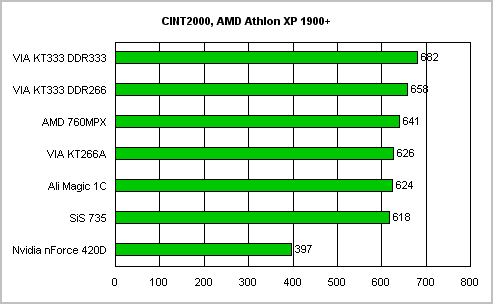 The CINT2000 tests depend mostly on a processor, that is why there is not a great difference between the systems. However, the NVIDIA nForce demonstrates quite low scores. In some reviews it is shown that the DASP technology affects an operating speed and can provide 25% gain in the synthetic tests (as compared with the VIA KT266A). But here the speed falls down by 37%. It's quite strange as these SPEC CPU2000 subtests are based on the well-known tasks, in particular, gzip, bzip2, gcc. And in the integer tests like Sysmark 2001 the nForce goes on a par with VIA KT266A based solutions. It seems that in this case the DASP doesn't allow the processor to show all its capabilities as it brings in delays in data exchange with the memory. Probably, the CFP2000 suite will give us new explanations. The results of the other chipsets differ not more than by 6.5% when working with the PC2100. The PC2700 used with the KT333 makes the gap equal to 10.4%. The chipset also brings excellent scores with the memory running at 133 MHz. The gain over the KT266A is 5.1%. The AMD 760MPX is a leader among the chipsets with PC2100. 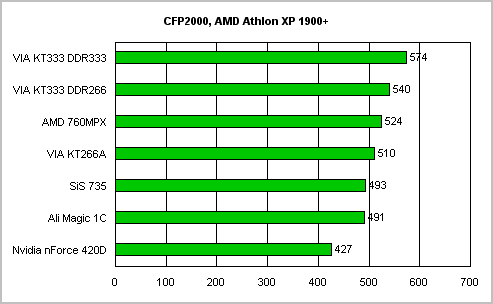 The integer score in operations with real numbers is very similar to the CINT2000, except that the ALi and SiS chipsets have exchanged their places. The NVIDIA nForce falls back again, and this time by 16.3% from the KT266A. The difference between the other results is 10% at most. The KT333 outscores the KT266A on the PC2100 by 5.9%. And the AMD 760MPX is again a leader among the DDR266 chipsets. Well, for dual-processor systems a speed of operation with memory is very important, and AMD engineers did their best for it. Tests in SMP configurations will be carried out later. While in the CINT2000 all the participants behaved equally, in the CFP2000 there are several interesting aspects. We will run 4 tests, two of which have proved to be very memory-intensive, and the two others - processor dependent. 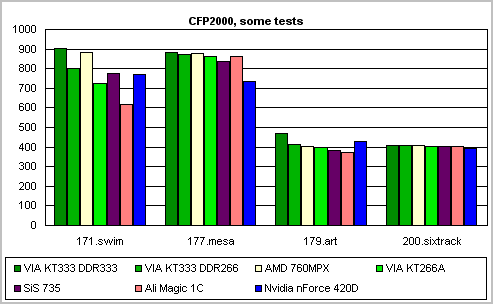 Here even the 171.swim and 179.art tests differ, though earlier we thought that they depended only on the memory bandwidth. In the first test the KT333/DDR333 and AMD 760MPX are leading, and in the second the nForce unexpectedly takes the second place, and the ALi MAGiK 1C falls behind. Remember that in the 179.art the program uses only 4 MBytes of RAM during the operation. The DASP helps the nForce this time and it shows the best result among all PC2100 configurations. In the 177.mesa and 200.sixtrack tests which both depend on a processor speed the nForce slows down in the first one, while goes at the same pace in the second test. ConclusionWell, in a few words, the best platform for the AMD Athlon XP processor is the VIA KT333 chipset coupled with the PC2700 memory. In detail:
Write a comment below. No registration needed!
|
Platform · Video · Multimedia · Mobile · Other || About us & Privacy policy · Twitter · Facebook Copyright © Byrds Research & Publishing, Ltd., 1997–2011. All rights reserved. |